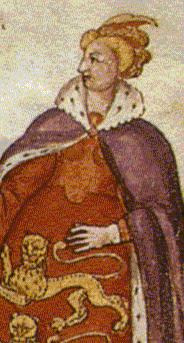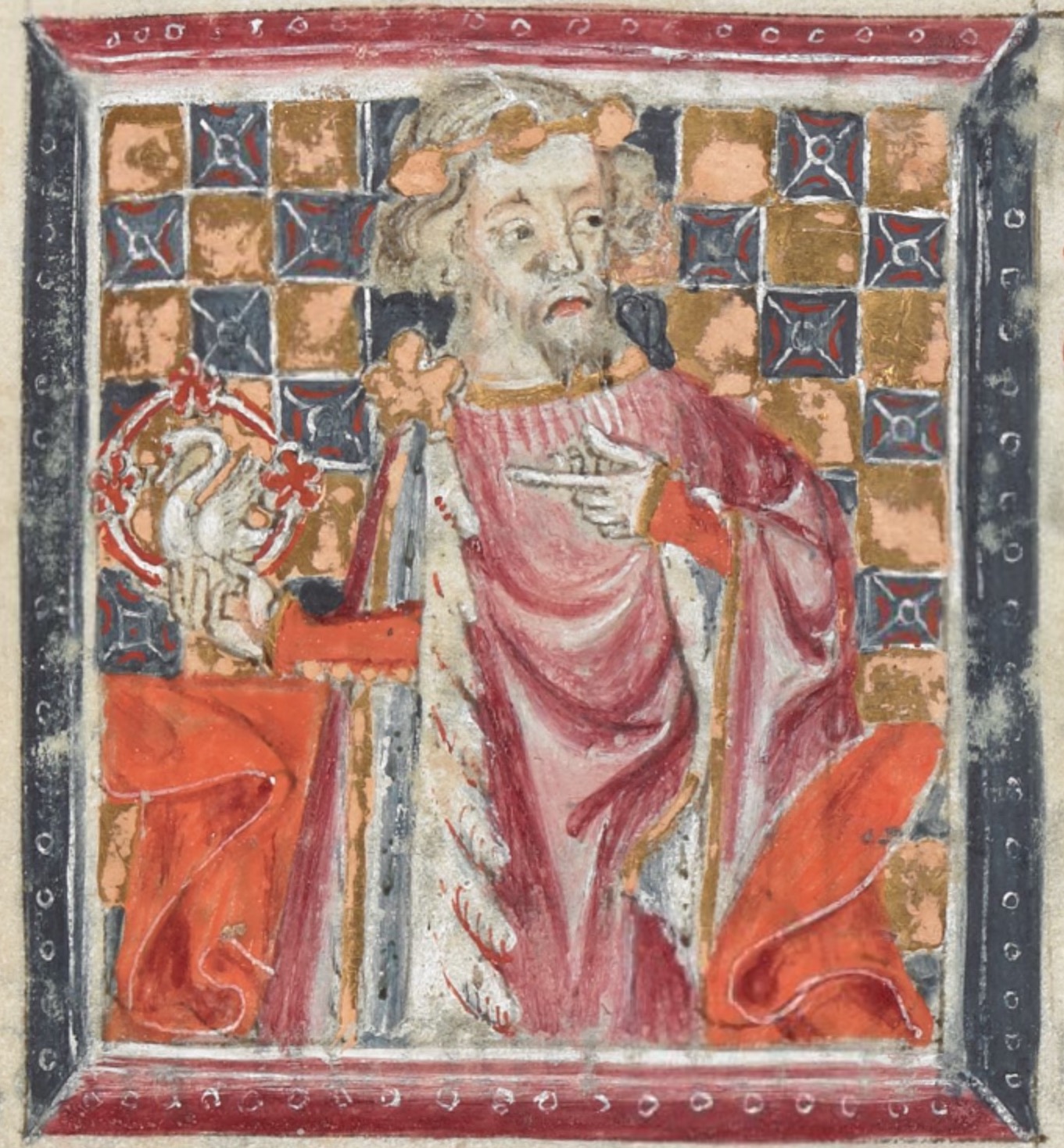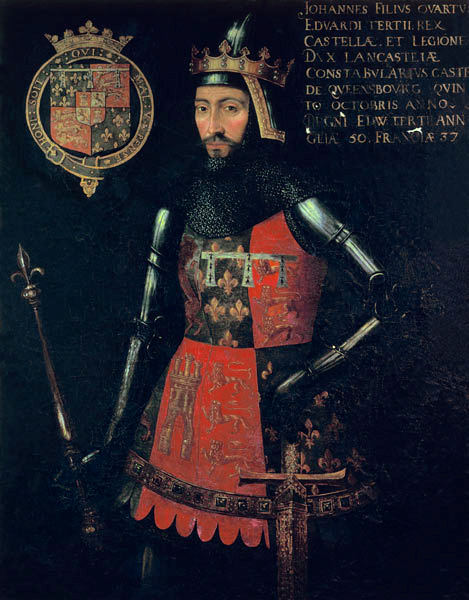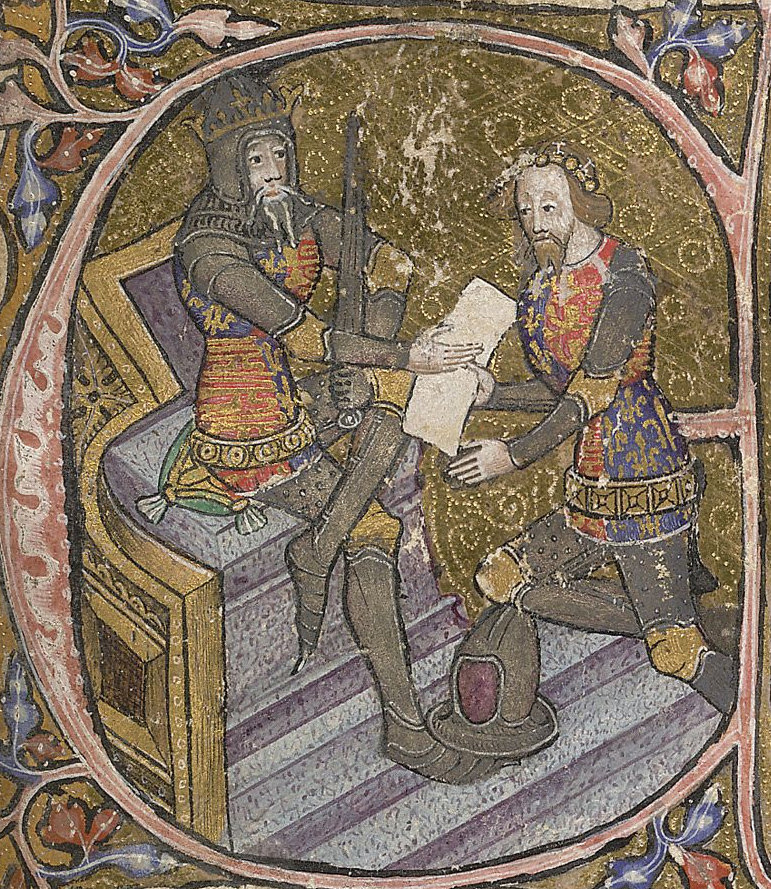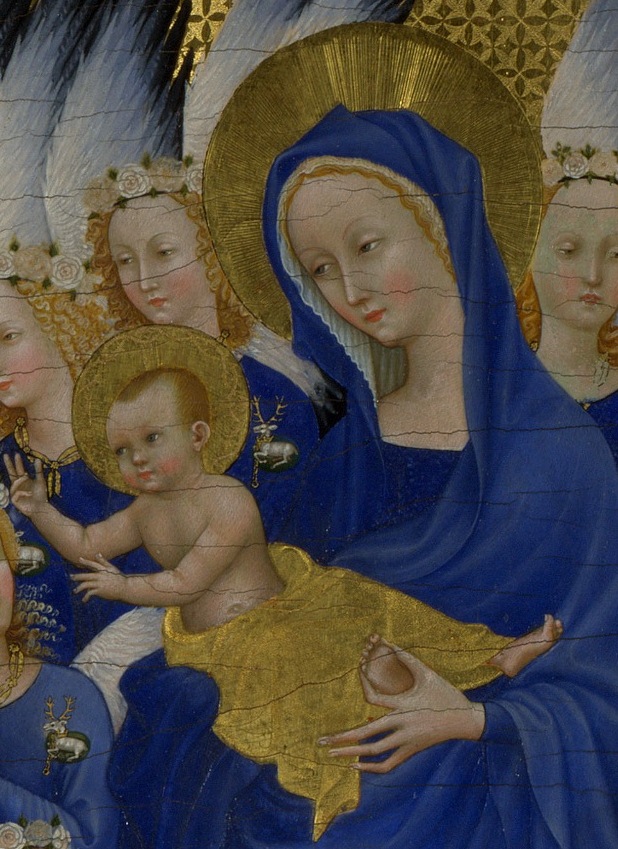by Susan Flantzer © Unofficial Royalty 2017

Arms of Thomas of Brotherton, 1st Earl of Norfolk; Credit – By Sodacan – Own work, CC BY-SA 3.0, https://commons.wikimedia.org/w/index.php?curid=27282076
Thomas of Brotherton was the eldest of the three children of King Edward I of England and his second wife Margaret of France. He was born on June 1, 1300, at the manor house in Brotherton, Yorkshire, England. His mother went into labor while she was traveling to Cawood Castle where she had planned to give birth. Margaret had prayed to St. Thomas Becket during her labor and named her son after him.

The parents of Thomas of Brotherton, King Edward I and Margaret of France; Credit – Wikipedia
Thomas had 14-16 half-siblings by his father’s first marriage to Eleanor of Castile, but only six survived childhood:
- Daughter (stillborn in May 1255)
- Katherine of England (before 1264 – 1264)
- Joan of England (born and died 1265)
- John of England (1266 – 1271)
- Henry of England (1268 – 1274)
- Eleanor of England (1269 – 1298), married Henry III, Count of Bar, had issue
- Daughter (born and died 1271)
- Joan of Acre (1272 – 1307), married (1) in 1290 Gilbert de Clare, 6th Earl of Hertford, had issue (2) in 1297 Ralph de Monthermer, 1st Baron Monthermer, had issue
- Alfonso, Earl of Chester (1273 – 1284)
- Margaret of England (1275 – after 1333), married John II, Duke of Brabant, had issue
- Berengaria (1276 – 1278)
- Daughter (born and died 1278)
- Mary of Woodstock (1279 – 1332), a Benedictine nun in Amesbury, Wiltshire
- Son (born in 1280 or 1281 who died very shortly after birth)
- Elizabeth of Rhuddlan (1282 – 1316), married (1) in 1297 John I, Count of Holland, no issue (2) in 1302 Humphrey de Bohun, 4th Earl of Hereford, 3rd Earl of Essex, had issue
- King Edward II of England (1284 – 1327), married Isabella of France, had issue including King Edward III of England
Thomas had one younger brother and one younger sister:
- Edmund of Woodstock, 1st Earl of Kent (1301 – 1330), married Margaret Wake, 3rd Baroness Wake of Liddell, had issue including Joan of Kent who married King Edward III‘s eldest son Edward, Prince of Wales (The Black Prince) and was the mother of King Richard II of England
- Eleanor of England (1306 – 1311), died young
Thomas’ brother Edmund of Woodstock was only a year younger and the two grew up in a household together, complete with luxuries as befitted their status as a king’s son. However, they were not the important royal children. That role went to their much older half-brother Edward, Prince of Wales who was the only surviving son of Edward I’s first marriage to Eleanor of Castile.
In the summer of 1307, Thomas’ mother Margaret accompanied his father Edward I on a military campaign in Scotland. On the way to Scotland, the 68-year-old king died on July 7, 1307, at Burgh by Sands in Cumbria, England. Thomas’ half-brother succeeded to the throne as King Edward II. Thomas was now the heir presumptive to the throne. Edward I had intended to give Thomas the title Earl of Cornwall, but instead, the new King Edward II bestowed the title upon his favorite Piers Gaveston along with the lands that brought Gaveston a substantial income. Many people, including Thomas’ mother, now the dowager queen, were infuriated that such an important title had been given to a person that was not family. In 1312, Piers Gaveston, the favorite of Thomas’ half-brother King Edward II, was hunted down and executed by a group of barons led by Edward’s uncle Thomas, 2nd Earl of Lancaster and Guy de Beauchamp, 10th Earl of Warwick. Also in 1312, Edward II’s wife Isabella gave birth to a son, another Edward, the future King Edward III. After the birth of his son, Edward II created Thomas Earl of Norfolk.
In 1316, Thomas was given the office of Lord Marshal of England. The title of “marshal” at one time designated the head of household security for the King of England. The office became hereditary under John FitzGilbert the Marshal and his second son William Marshal, 1st Earl of Pembroke, served four kings (Henry II, Richard I, John, and Henry III) in this office and became one of the most powerful men in Europe. The office of hereditary Marshal (currently Earl Marshal) evolved into a Great Officer of State. In 1672, the office of Marshal of England and the title of Earl Marshal of England were made hereditary in the Howard family and since then the offices have been held by the Duke of Norfolk. Today, the Earl Marshal’s role is chiefly involved in organizing major state ceremonies such as coronations, state funerals, and the opening of parliament.
Around January 8, 1326, Thomas married Alice de Hales, daughter of Sir Roger de Hales of Hales Hall in Loddon, Norfolkshire, England. Through their daughter Margaret, Thomas and Alice are ancestors of the two beheaded wives of King Henry VIII, Anne Boleyn and Catherine Howard, who were first cousins.
Thomas and Alice had three children:
- Edward of Norfolk (circa 1320 – before 9 August 1334), married Beatrice de Mortimer, daughter of Roger de Mortimer, 1st Earl of March, no issue
- Margaret, Duchess of Norfolk (circa 1320 – 1399), her father’s heir, succeeded to the Earldom of Norfolk and the office of Earl Marshal at her father’s death in 1338, created Duchess of Norfolk in 1397, married (1) John Segrave, 4th Baron Segrave, had issue (2) Sir Walter Manny, had issue
- Alice of Norfolk (circa 1324 – circa 1352), married Edward Montagu, 1st Baron Montagu, had issue
Thomas’ first wife Alice died in 1330. After her death, Thomas married Mary de Brewes, daughter of Sir Peter de Brewes of Tetbury, Gloucestershire. Thomas and Mary had no surviving issue.
After the execution of Piers Gaveston in 1312, Hugh Despenser the Elder became part of King Edward II’s inner circle, marking the beginning of the Despensers’ increased prominence at Edward’s court. His son, Hugh Despenser the Younger, became a favorite of Edward II. Edward was willing to let the Despensers do as they pleased, and they grew rich from their administration and corruption. Thomas of Brotherton became a victim of the Despencers’ greed when Hugh Despenser the Elder stole some of his land. Thomas then allied himself with Queen Isabella and her lover Roger Mortimer, 1st Earl of March when they invaded England in 1326. With their mercenary army, Isabella and Mortimer quickly seized power from King Edward II. Thomas was one of the judges in the trial against both Despensers where they were both sentenced to death. King Edward II was forced to abdicate, his son was crowned as King Edward III, and Isabella and Mortimer served as regents for the teenage king.
Many nobles were jealous and angry because Mortimer abused power. Three years after King Edward II was deposed, Thomas’ brother Edmund, 1st Earl of Kent was accused of high treason on charges of having attempted to free the former king from imprisonment. It later emerged that Roger Mortimer himself was responsible for leading Edmund to believe the former king was still alive, in a form of entrapment. Edmund, 1st Earl of Kent was executed at Winchester Castle on March 19, 1330. After this execution, the nobles begged the young king to assert his independence, which he did shortly before his 18th birthday. After King Edward III regained power from his mother and Mortimer, his uncle Thomas became one of his principal advisors.
Thomas of Brotherton, Earl of Norfolk died at Framlingham Castle in Suffolk, England on August 4, 1338, at the age of 38. He was buried in the choir of the Abbey of Bury St Edmunds in Suffolk, England. The abbey was disbanded during King Henry VIII’s Dissolution of the Monasteries when the abbey was stripped of all valuable building materials and artifacts. The abbey ruins were then used as building materials by the local people.

Remains of Bury St Edmunds Abbey, Suffolk, England; Photo Credit – John Armagh, Wikipedia
This article is the intellectual property of Unofficial Royalty and is NOT TO BE COPIED, EDITED, OR POSTED IN ANY FORM ON ANOTHER WEBSITE under any circumstances. It is permissible to use a link that directs to Unofficial Royalty.
Works Cited
“Earl marshal.” Wikipedia. N.p.: Wikimedia Foundation, 24 Oct. 2016. Web. 18 Dec. 2016.
Jones, Dan. The Plantagenets. New York: Viking, 2012. Print.
Susan. “King Edward II of England.” British Royals. Unofficial Royalty, 21 July 2016. Web. 18 Dec. 2016.
Susan. “King Edward III of England.” British Royals. Unofficial Royalty, 4 Sept. 2015. Web. 18 Dec. 2016.
Susan. “Margaret of France, queen of England.” British Royals. Unofficial Royalty, 19 July 2016. Web. 18 Dec. 2016.
“Thomas of Brotherton, 1st earl of Norfolk.” Wikipedia. N.p.: Wikimedia Foundation, 4 Oct. 2016. Web. 18 Dec. 2016.



